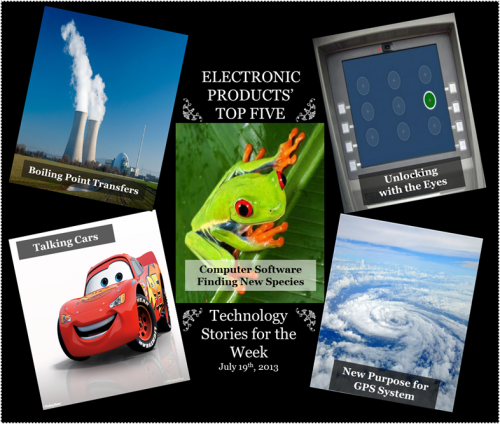
This week the hit children’s movie Cars comes to life, safety precautions for nuclear power plants are about the get stiffer, passwords may be moving to an eye recognition level, and frog calls can be detected by computer software. Be sure to check out the newest innovations with your top five technology stories for this week!
New Purpose for GPS
GPS to Be Used for Hurricane Tracking
We know GPS systems can direct a car or plane home, but in a storm, the information stands the risk of becoming skewed and fuzzy. Rather than figure out a workaround, researchers decided to embrace this shortcoming. A team at the NASA Langley Research Center is working with the distorted readings from GPS systems to benefit meteorologists by telling them where a storm is heading and how fast the winds are. When “Hurricane Hunter” planes are observing storms, the GPS shoots radio waves down to the earth where they hit the ocean’s surface and detect the speed of the wind while working with the wave height.
Talking Cars
Vehicle-to-Vehicle Communication Between Cars on the Road
What driver doesn’t want to avoid traffic jams and hazardous driving conditions? Vehicle-to-vehicle (V2V) transmissions, developed by the North Carolina State University Electrical and Computer Communications team, will allow cars to help each other around road barriers. There is little time delay between V2V communications, which makes them stand out against traffic-detecting smartphone apps. This system works with the radio frequencies, but the team is working out kinks in the reflection of radio waves bouncing off other cars and moving objects. Dr. Dan Stancil, head of the project, says they are going to “continue fine-tuning the model” for the future.
Boiling Point Transfers
New Discoveries in Boiling Liquid Improve Power Plants
MIT researchers have perfected the process of heat transfer between a surface and a liquid, which could ultimately help power plants, high-power electronics cooling, and vehicles traveling in water. The main point where the transfer is made is called the critical heat flux, and this is the unit and time where the surface changes. This cooling method could help nuclear-plant systems because of the nanoparticles that deposit on the surfaces, which then raised the critical heat flux and made it safer. The team found that porosity was the main cause of critical heat flux as opposed to the common thought that wettability was the cause.
Unlocking with the Eyes
Tracking Eye Movement Is the Alternative to Passwords
Do you seem to forget your numerous passwords and PIN numbers? As an alternative to constantly resetting and losing passwords, the University of Washington engineers are working on bringing eye and face recognition to mainstream password-retrieval websites. The idea is first being demonstrated through an ATM prototype, where users are told to follow a dot on the screen with their eye and the system reads their individual eye movements. This biometric authentication process is more accurate and efficient than writing down a list of passwords. The dot-locating method scored well because of the short time it took to recognize the user.
Computer Software Finding Hidden Species
Technology Tracks Species in Ecosystems
A team of scientists from the University of Puerto Rico promise that they are not trying to take jobs from biologists with their new species-tracking system. Their method uses web-technology to record acoustics of species in remote ecosystems with automated recording devices placed there. Using software and in-situ hardware, the team has made it possible to follow the species’ reaction to deforestation and climate change over a long period of time, not just for a short observation. The system can listen to over one million recordings and make observations from them.
Advertisement
Learn more about Electronic Products Magazine





